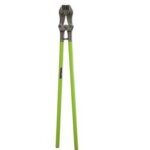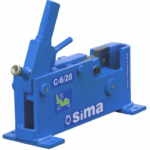Poured concrete countertops are very fashionable right now. They are aesthetically very versatile, and can easily fit in a rustic or contemporary kitchen, and they are also durable and inexpensive compared to granite. Many DIYers have taken on a project of installing concrete countertops in their kitchen, but many amateurs make one critical mistake: not reinforcing, or reinforcing incorrectly. Fortunately, you can use your rebar cutter to make quick and easy work of properly reinforcing your poured concrete countertops so that they look fantastic and stand the test of time. In this article, we assume that you have already prepped the countertop with a plywood bed, added molds around the edges and blocked off sinks, faucet holes, and so on.
Contents
Cutting rebar for concrete countertops
The first mistake people make is using rebar that is too big for the depth of countertop they are pouring. Keep in mind that the rebar will be laid in a grid, so the thickness of the rebar will actually be doubled. If your countertops will be around 2-3” thick, your best bet is to use either: half #3 rebar (3/8” thick) and half pencil bar (3/16” thick) or masonry wire, or skip the #3 rebar entirely and use only pencil bar and/or galvanized masonry wire.
Using your rebar cutter
Before you cut your rebar, you’ve got to measure, and before you measure, make sure that you have blocked off any sinks, etc. with wood planks that are as tall as your molds are around the edge. The majority of the tension that will be placed on your concrete countertop will occur along the long axis, so you should plan to have long cuts spaced at shorter intervals than the short cuts. One recommendation is to cut rebar for the long axis, spaced 6 inches apart, and then cut your pencil bar or masonry wire for the long axis and the short axis. Alternate the rebar and masonry wire along the long axis, so that there are 3 inches between the reinforcements. Then, lay the short cuts of masonry wire perpendicular and tie the rods together with tie wire.
Now, your rebar is cut and your reinforcements are perfectly laid. You’re ready to mix and pour your concrete! Avoid pushing your rebar grid down into the concrete after pouring, as this may affect the finish.
Rebar cutter safety precautions
Cutting through 3/8” of steel is no easy task, and rebar cutters apply an enormous force on the rebar in order to cut it. This force can send pieces of metal flying out from the cutter if you aren’t careful. Always protect yourself by wearing appropriate clothing, shoes and eye protection (even a face shield is a good idea when working with smaller cuts of rebar). Also, ensure that bystanders are protected by constructing a work screen around your cutting area. Take special care when making cuts that leave a piece of rebar that is less than a foot long, as these are the most susceptible to taking off and causing injury.





